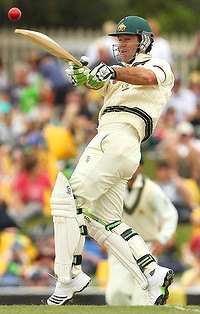by Joey Fuller
(Australia)

Ricky Ponting : Master Of The Pull(Getty Images)
Hello, I’m a 16 year old short all rounder who sometimes opens the batting. I was really strong on the back foot until a month ago when I was facing a quick bowler and top edged an attempted pull through my helmet to my eye.
Ever since then I haven’t been able to go on the back foot. My coach says I just need to regain my confidence and should start playing the shot again but I haven’t been able to no matter how hard t try convince myself. Any tips on overcoming this barrier.
Hi Joey,
thanks for the letter, it takes a lot for a sportsman to admit fear of any kind and to acknowledge it is the first part of getting back on track and playing your best cricket.
So let’s lay out a series of steps to get you batting better than ever, off front and back foot.
The great thing is that this is a simple process, it will also make you a better cricketer for the future, as you overcome this mini setback and take the learning out of a painful experience.
Step1. Set A New Goal:
Let us set a new goal, to use what happened to you, to make you a better player of fast bowling.
What’s happened is over and done with and we don’t want to bring it back to life everytime you have to go and face the quicks, so we install new positive thoughts and feelings.
Step 2. Review:
Write down everything that comes to mind about what happened. Think back to any other times you have been hit in the head playing ball sports, make a note of them as well.
Now look at your notes, you received a ‘trauma’ to the head, it’s natural for your ‘inner mind” (subconscious mind) to want to protect you by not wanting you to bat again or face quick bowling. If there were other times you have been hit in the head, review what happened.
Using Logic. Let’s look at this logically now, acknowledge the fact you’ve been hit in the head and that it is okay for your inner mind to want to protect you. (Its important you get the subconscious mind on your side, if it isn’t, you can consciously want to go face the quicks but a part of your subconscious mind won’t want you to … it won’t want to put itself in a position of getting hit again and experiencing the pain that goes with it.
Acknowledge that you made an error of judgement, focus or technique. This happens, its part of learning to play better cricket and playing hard ball sports. The best players in the world make these ‘mistakes’ every time they play. It’s a case of learning to minimise them. Ricky Ponting got hit in the head by Steve Harmison and Ponting is one of the best players of short bowling there is.
Step 3. Positive Image Rehearsal:
Having reviewed what happened, now imagine playing the ball again, how would you change how you played it? You can even imagine how your favourite player would play it, a Ponting, Tendulkar or Kallis perhaps.
What would you do differently?
Write down how you would play it if you were playing it again, perfectly. Keep it simple and positive.
Something like…
” I’m in the crease, calm and focused, I remind myself to ‘watch the ball’ * … I’m watching the bowler run up, I focus on the ball in his hand, as he releases the ball I see the ball is short of a length, it is the perfect height for me to pull, I move effortlessly into position and pull the ball powerfully through midwicket for four.”
(* I’ve put this in as its a good habit to get into, to remind yourself to watch the ball … most errors in batting come from not watching the ball closely.)
Now we have a picture and the feelings of playing the shot exactly as you want to.
Close your eyes and run this through in your mind … see it and feel it … ( play around with this) … make it in colour so that it is bright and vivid, hear the sound of the ball cracking off the bat, the feeling of perfect timing and power.
We then join this up with positive self talk … the most important things are said to us by ourselves.
Step 4. Positive Self Talk: Now write down all the positive beliefs you had or want to have about your batting and playing fast bowling.
‘I’m one of the best batters I know … I’m a great player of fast bowling … I love facing the quicks … I love pulling and hooking … I love the challenge of facing the quicks … I’m a great puller … I have superb judgement, I see the ball early and play effortlessly … Even great players get hit, its how I come back that counts …
From these choose a favourite saying … to add at the beginning and end of your imagery.
Now we put these two key parts together … you practise the positive imagery 4 or 5 times a day for 30 seconds … just take a moment, wherever you are and play it through. Begin and finish with your favourite batting saying.
Do this for 3 weeks or so … let the brain make new connections and wiring … to make the dominant thoughts and feelings positive about facing the quicks … come back to it during the season when you need to.
Step 5. Practical Batting Practice:
Begin with short ball work with a tennis ball or slaz ball, both underarms and overarm ….slower speeds, hitting the ball over midwicket and down on the ground. Get the focus and feel of watching the short ball and playing it with good intent. Practice your pull, cut, hook and defence.
Build this up, to using hard balls again, slower speeds and then quicker over a few weeks.
Use your positive self talk to re-inforce positive thoughts and feelings.
Be patient with this, don’t rush it, its important not to force the subconscious mind. Trust it, it will work for you.
Happy and successful batting … Coach

About Richard Pybus
I'm Richard Pybus, I've coached Pakistan, Bangladesh, Middlesex, Titans and the Cape Cobras in South Africa and the goal of this site is to help you to play winning cricket.
